|
Non-spherical Planets
|
|
| FastFourierTransform | Date: Sunday, 09.10.2016, 19:20 | Message # 1 |
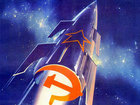 Pioneer
Group: Local Moderators
 Spain
Spain
Messages: 542
Status: Offline
| This is an amazing topic I've encountered recently (some of this things are incredibly interesting and not very famed)
Introduction to the topic (skip it if you know what hydrostatic equilibrium means)
Why the shape of planets is a Sphere? Let's see if I can explain it with rigour.
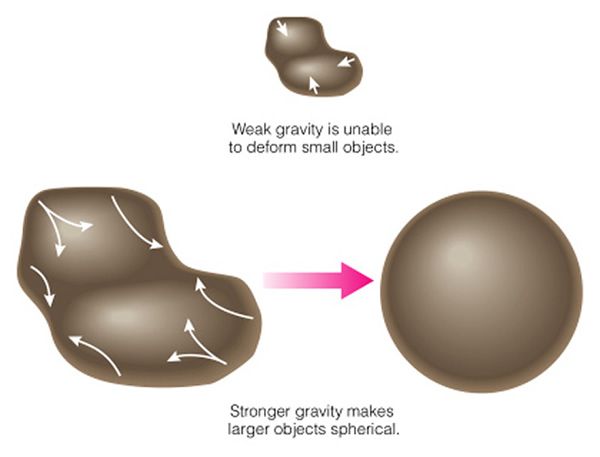
In the most simple case, planets reach hydrostatic equilibrium in the spherical solution. If there where large prominences over the surface then gravity would make them collapse, so the planet usually gets rounder and rounder. This is the reason why Mars (that has a lower gravity) can have Volcanoes as tall as Olympus Mons while a structure on Earth can't even reach a third of that height.
But the sphere is not the only solution for the hydrostatic equilibrium problem (solve the shape of a planet knowing nothing more than the potential well it's on). In fact the sphere is a solution only for the case where the gravitational well is radially symetric (isotropic), as is for the gigantonormous majority of planets.
To understand this we can use a simplier model. Imagine you pour a liquid (or a cat) on this vase:

You can probably see that the shore of the liquid (cat interior-exterior boundary) would form a circounference as a result. This is equivalent to the hysdrostatic equilibrium problem but in 2D for a planet (the vase is the potential well obviously).
Oddly shaped planets must appear when the gravitational well is different from that and has asymetries. For example, if two stars get to close toghether they become a contact binary system and the potential well has asymetric regions called Roche Lobes. In terms of forces (equivalent description of that of energy potentials) is simplier to visualize: you have that a point on the surface of the star can have different gravitational atraction to other point on the surface so the region that is closer to the companion gets spaghettified until it touches the other star, like this:

Gravity potential wells can be of many shapes if you see them from a non-inertial reference frame. When you are in a non-inertial reference frame misterious forces called fictitious forces appear (for example the Coriolis force on the Earth's surface, because Earth's surface is a non-inertial reference frame due to change in the direction motion around the Earth's axis). You are not going to find a more beautifull and well explained syntesis on what a fictitious force is than this old movie.
We relate potentials to forces. Gravity potential is associated with the famous force described by Newton. And fictitious forces in general have their own potential fields associated to them that change the gravitational potential appearance including a new term due to the non-inertial frame of reference perspective. So potentials can even be deformed by non uniform relative motion beetween the parts of the system and not only by the presence of real potential energy fields.
For example, in a two body problem (as the Earth and the Sun rotating around a common barycenter) it's easy to imagine a point in space where the pull of gravity of the Sun plus the pull of gravity of Earth cancel each other out creating a point of equilibrium (the so called L1 point). But there are in fact 5 Lagrange points in this kind of system (four more places of equilibrium), that are not as intuitive at all. Those L2, L3, L4 and L5 points appear when you consider the potential from a co-rotating frame (a frame that mantain the Earth-Sun line motion-fixed). In the more extreme case of contact binary stars the potential well as viewed from the co-rotating frame (the frame where both stars are living) has this shape:
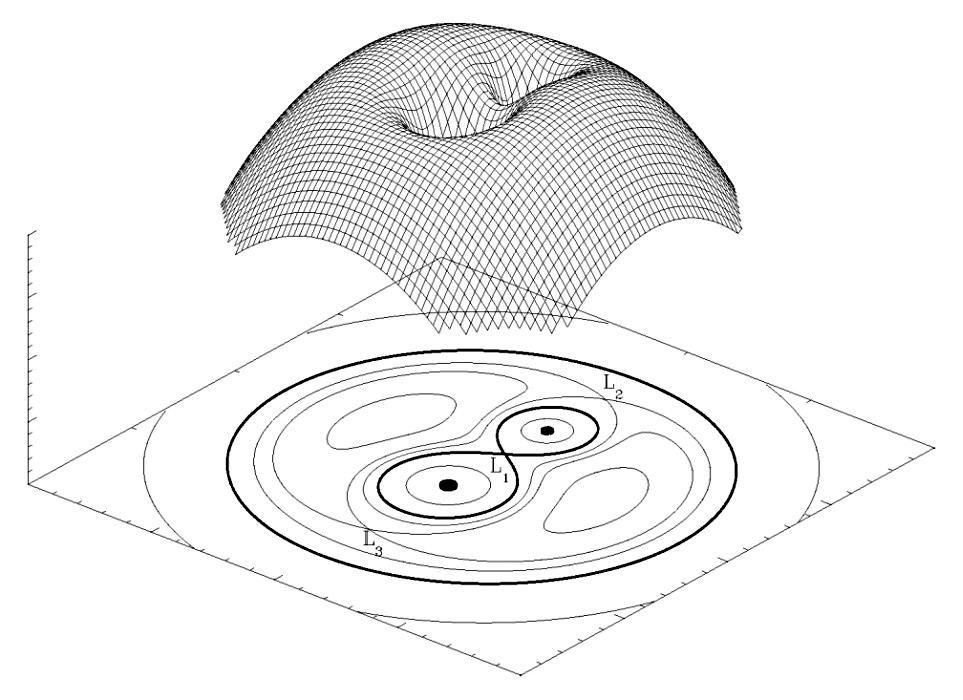
As you can see the five points of equilibrium are easily visualized in this manner. If you pour liquid into this vase you would fill the roche lobes with a shoreline in the shape of that presented above, A little bit of water would stay in unstable equilibrium at the 5 lagrange points (until it falls inside the lobes/stars or falls away). The rest of the water falls away inmediatly (is expelled out) because of the slope that sorrounds the system, this can be thought as matter expelled by centrifugal forces (because we are in the co-rotating frame and centrifugal forces are fictitious ones). If the frame was an inertial one, the well wouldn't have that falling slope away from the center but a planar form.
In fact Space Engine has planets that are not spherical at all: oblate planets. Due to the fast rotation of some planets, the equator, (that experiences centrifugal forces) is enlarged and the poles get closer toghether making the planet an oval spheroid. This can be thought of as a potential well that has elipsoids as iso-potential surfaces (same potential levels in 3D). The rotation of planets never exceeds certain amounts (if it did it would be torn appart) so the oval shape is quite difficult to notice. For example, Jupiter, that has a 10 hour rotation period compared to aperfect circle looks like this:

.
Rocheworlds: Contact Binary Planets
Stars are made of plasma, that follows easily the laws of fluids so Contact Binary systems have well know shapes for their components (asymetrical lobes that touch one another with proboscides). But solid planets are another thing. Or are they? The problem here is that if you have a Binary Planet (they exist in SE currently) and make the components sufficiently close, they could reach the Roche Limit and be torn appart or their roche limit could be inside the other body so they could acquire the hydrostatic shape instead of crack and release big chunck of both planets to space.
The idea of the so-called Rocheworlds is explored in this hard science fiction novel, The Flight of the Dragonfly, where two planets share an atmosphere:

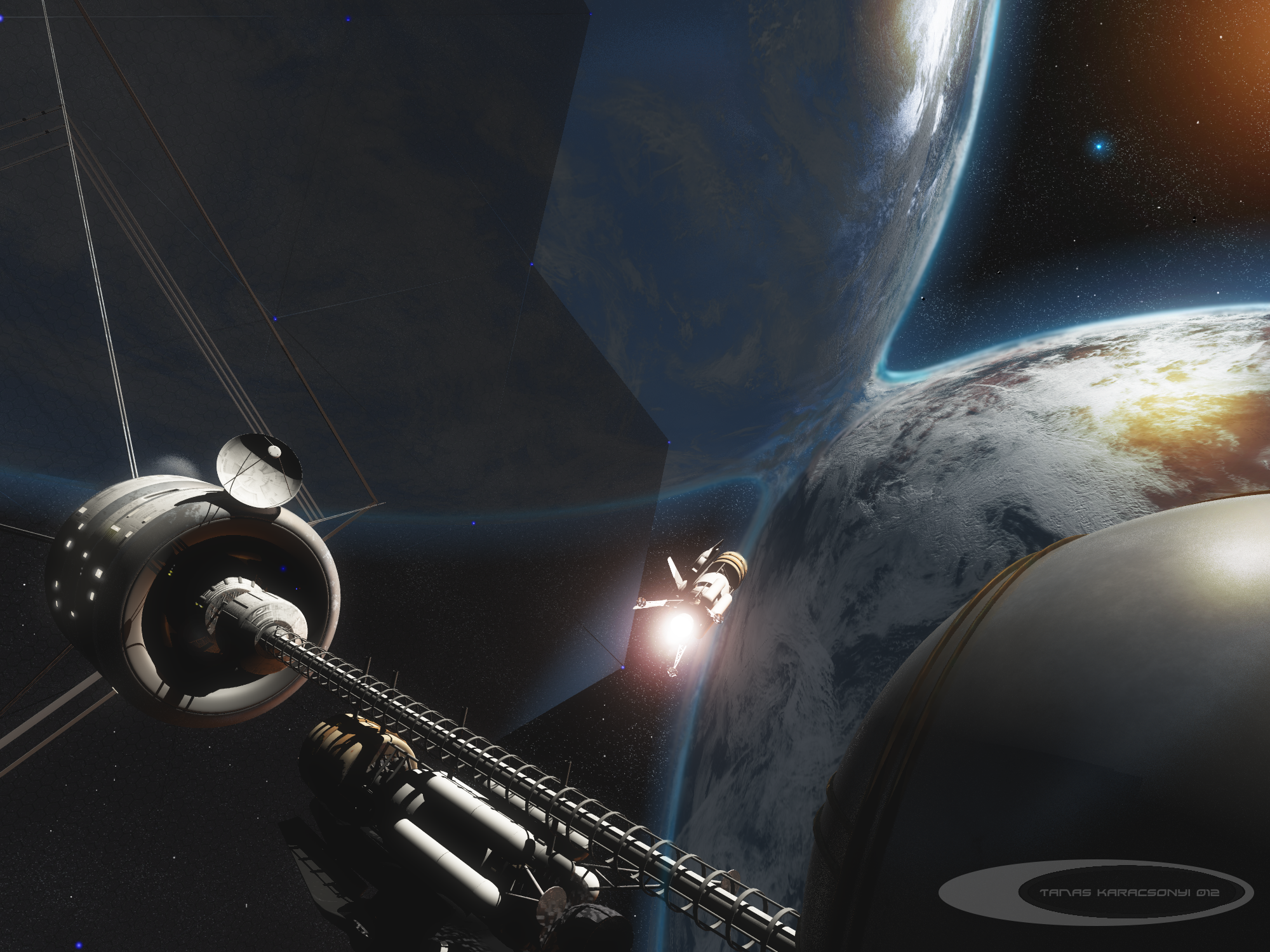
Robert Forward was a physicist and made the calculations himself for this kind of double planet.
There are contact binary stars and contact binary asteroids and cometary nuclei, but we have never found this phenomena to occur for the range of masses of planets. The problem is that the planets have to fill their roche lobes (so the contact can occur) and at the same time thay have to be sufficiently separated as to not get disrupted by the roche limit of the other. If you separate the components the roche lobes get bigger so you have to fill more of space, so the problem is tunning some parameters (mass, density and distance between the planets) to get the adecuate configuration.
Discussion
There are discussions about this here (concludes that this can be done), here (the best answer concludes that probably they can't exist but just in the most simple model), here and here.
This discussions model the interaction in a simple way so there is a lot of uncertainties. For example in the last discussion it is said that for this kind of system to exist we need the roche limit to be smaller than the sum of the radii of both planets (sounds good). Considering equal density for both planets the result is that the radius of the smaller planet has to be at least 26% of the radius of the primary component to create a contact binary.
But this calculation is based on a formula for the roche limit that is shown as the "rigid satellite calculation" in the wikipedia article. This is good for a planet and a small satellite but not good for our case. In fact, since the masses of the components of rocheworlds have to be similar the rotation of the systems plays a huge role, so the formula for the roche limit has to account for centrifugal foces also (as shown in the same wikipedia article in "A more accurate formula"). Not only but this formula is also not precise for our purpose because it doesn't consider the flattering of both components (something that pushes the roche limit farther from each component) and indeed both components are not spherical (since we want them to fill their roche lobes). The calculation can get inmensly complicated (the roche limit formula for oblate spheroids is shown on the "fluid satellites" section of the wikipedia article). So we have to consider how much the components are going to be deformed filling their roche lobes to tell if they are still over the roche limits of one another so they don't get disrupted and mantain their "contact neck" stable. Other issue that has to be considered is how the density would change. If someone is brave enought to do the calculations in a more rigorous way it would be amazing (I probably would do them if I have time in the future)
For Gas Giants it's probably possible to have contact binaries (they are similar to small stars in sizes) and probably you could have their more denser nuclei away from the roche limits of the other component even if their gaseous atmospheres are under the limit of the other (the atmosphere is "disrupted by tidal forces" but create a gaseous neck while the nucleus of both planets remain in good health).
Epic view of two gas giants sharing a storm for example:

Could it be for planets like Earth? Maybe.
If this is going to be implemented in SE I recommend this calculators for hydrostatic equilibrium shapes in contact binaries (in stars but it can be introduced in planets also). The first one is called RoLo and the second one is called StarLight Pro (the software also allows for light curves identification). Both have documents to see the kind of calculations they do and allow to create your own calculator (document for RoLo and the document for rendering contact binaries in StarLight Pro).
You have also these free excell calculators that compute different important aspects of contact binaries:
Possible Evolution
But how a system can get to this configuration? Double planets (even terrestrial ones) are not impossible at all, they are probably out there (SE depicts them right now). Some process could bring the planets together.
For example, immagine that each component of the binary planet starts its life rotating slower than the orbital period of the other component. This means that both they orbit each other closer than their respective geosynchronous orbits. In this case tidal friction would not only tend to tidally lock both objects in a few million years but would alsosrink the sizes of their orbits (exchanging momentum from the orbital movement to the rotational one so the days would get quicker until the tidall lock is complete). For this process to occurr at a fixed initial separation you only need sufficiently slow rotating planets and sufficiently large timespans. In the end you would have both planets much more closer and in tidal locking configuration. Then, maybe at this distance some mechanism (for example friction with the exosphere of the other planet) could slowly bring the planets closer and closer. Other mechanism that could operate in planets without atmosphere is as follows, the tidal stress generated by the close vicinity of the other component could ignite volcanic massive activity on the crust and gasses could eventually scape through the potential neck (crossing L1) to the other planet making an angular momentum transport and some friction in the other component. Finally at some point they would fill their roche lobes and a contact neck would connect both bodies (this is always if the planetary masses, densities and distances are those needed to avoid simple tidal disruption). I don't know if this configuration would be preserved in geologic times but maybe in thousands of years it could be. The system would rotate very fast. In the end, if atmosphere is present (or just by the emmision of gravitational waves), both boides would eventually merge slowly creating a big fast rotator planet.
What do you think?
Are this planets even possible?
And, if the realism is accomplished, would SE render Rocheworlds one day?
In the next episode: Toroidal Planets! 
Edited by FastFourierTransform - Sunday, 09.10.2016, 19:27 |
| |
| |
| steeljaw354 | Date: Sunday, 09.10.2016, 20:30 | Message # 2 |
 World Builder
Group: Users
 Pirate
Pirate
Messages: 862
Status: Offline
| Now those images are just stunning! Has anyone made a Toroidal world or Rocheworld in space engine?
|
| |
| |
| Watsisname | Date: Sunday, 09.10.2016, 20:55 | Message # 3 |
 Galaxy Architect
Group: Global Moderators
 United States
United States
Messages: 2613
Status: Offline
| I am trying very hard to get through this amazing post, but I am currently stuck on the part with liquid cats. 

|
| |
| |
| DoctorOfSpace | Date: Sunday, 09.10.2016, 20:57 | Message # 4 |
 Galaxy Architect
Group: Global Moderators
 Pirate
Pirate
Messages: 3600
Status: Offline
| You can make them as catalog addons and sometimes hiccups in the generation can create things like touching planets. Also any small disturbance would probably cause those planets to collide, in space all orbits are jostled. It is highly unlikely such a pair would form, most likely they would migrate closer and then just collide. I have made pairs before in Universe Sandbox, but they sadly all ended in planetary collisions.
Quote FastFourierTransform (  ) In the next episode: Toroidal Planets!
Intel Core i7-5820K 4.2GHz 6-Core Processor
G.Skill Ripjaws V Series 32GB (4 x 8GB) DDR4-2400 Memory
EVGA GTX 980 Ti SC 6GB
|
| |
| |
| Alek | Date: Sunday, 09.10.2016, 23:50 | Message # 5 |
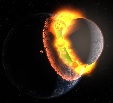 Pioneer
Group: Users
 United States
United States
Messages: 326
Status: Offline
| If life somehow managed to form on one or both planets, would the eventual merging off them kill the life present, or would it be slow enough not to cause mass or complete extinction?
Living among the stars, I find my way. I grow in strength through knowledge of the space I occupy, until I become the ruler of my own interstellar empire of sorts. Though The world was made for the day, I was made for the night, and thus, the universe itself is within my destiny.
|
| |
| |
| DoctorOfSpace | Date: Monday, 10.10.2016, 00:22 | Message # 6 |
 Galaxy Architect
Group: Global Moderators
 Pirate
Pirate
Messages: 3600
Status: Offline
| Quote Alek (  ) would the eventual merging off them kill the life present, or would it be slow enough not to cause mass or complete extinction?
Once they reach the point of collision it's going to happen quite quickly and everything is going to die.
Intel Core i7-5820K 4.2GHz 6-Core Processor
G.Skill Ripjaws V Series 32GB (4 x 8GB) DDR4-2400 Memory
EVGA GTX 980 Ti SC 6GB
|
| |
| |
| JackDole | Date: Monday, 10.10.2016, 07:35 | Message # 7 |
 Star Engineer
Group: Local Moderators
 Germany
Germany
Messages: 1742
Status: Offline
| Rocheworld

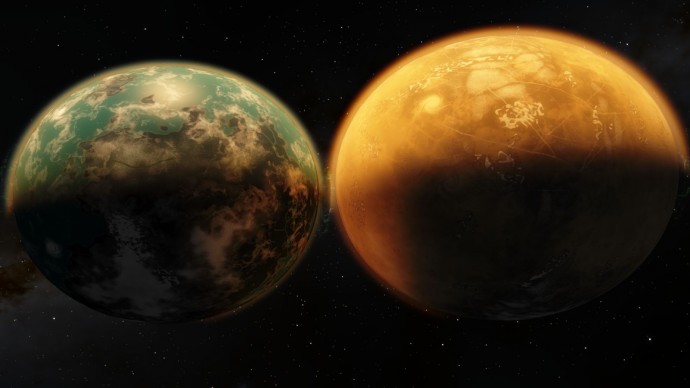
Unfortunately not quite up-to-date.
Don't forget to look here.

|
| |
| |
| FastFourierTransform | Date: Monday, 10.10.2016, 15:35 | Message # 8 |
 Pioneer
Group: Local Moderators
 Spain
Spain
Messages: 542
Status: Offline
| Quote DoctorOfSpace (  ) It is highly unlikely such a pair would form, most likely they would migrate closer and then just collide.
In reality I fell in the same way. My argument is as follows
There are many many Stellar Contact Binaries known to our species (Around 10.000 by now), that range from systems as big as VFTS 352 (very massive contact binary consisting of a 28,8 solar masses O4.5 star and a 28,6 solar masses O5.5 star) to systems like SX Corvi (composed by a 1,25 solar masses and 0,1 solar masses). The density of this kind of systems is of 5 contact binaries per ten million cubic light years (5 contact binaries in the firsts 1545 light years from Earth), meaning that in the Milky Way there are ~90 million of those systems (consider this for SE).
There are also many examples of Minor Planet Contact Binaries. [url=https://en.wikipedia.org/wiki/Contact_binary_(small_Solar_System_body)]About 10–15% of near-Earth asteroids larger than 200 meters, as an example, are expected to be contact binaries[/url] with two lobes in mutual contact. Here you have a gallery of some clear and some speculated contact binaries:
For the case of minor planets, contact binaries are stable because both components excert little gravitational forces and the material structure is capable of mantaining the components separated by the neck (the neck can handle the weight). In the case of stars this doesn't exist but you have huge centrifugal forces, due to the enormous rotation speed, due to the great masses involved (the inertia of this huge masses needs a lot of friction to get them merged). So you can have, for completely different reasons, contact binaries for masses like asteroids and masses like stars. Would masses like planets be capable of sustaining this kind of structures for some period of time? If the lifespan of this configuration is greater than 1000 years I think it should be included in SE (you could eventually find an example).
Quote JackDole (  ) Unfortunately not quite up-to-date.
WOW JackDole, I knew that you where going to make this for some reason 
Great addon. But the problem is that Rocheworlds would have their roche lobes filled and they wouldn't have a triapsal ellipsoid shape at all but a more asymetric one. We probably would have to wait to Space Engineer for this 
Quote Alek (  ) If life somehow managed to form on one or both planets
I think that if this happens and the situation remain stable for thousands of years, or if life arises in very close (but not contact) binary planets, lithopanspermia would transfer life from one component to the other fairly quickly. Maybe even microbes suspended in the high atmosphere could make the trip to the other planet surviving.
Quote Watsisname (  ) I am trying very hard to get through this amazing post, but I am currently stuck on the part with liquid cats. biggrin
Hahahaha, Thanks.
The liquid cats are real. A new branch of fluid dynamics in physics is developing:

Next Nobel price for the new state of matter cats

The gaseous cat

|
| |
| |